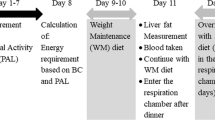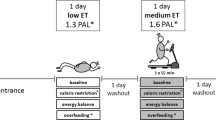Abstract
OBJECTIVE: To compare resting metabolic rates (RMR) of African-American (n=25) and Caucasian (n=22) premenopausal (35±1 y, Mean±s.e.m.) women who are obese (95.2±2.9 kg, body mass index (BMI)=34.7±0.9, % body fat=45.2±0.9), inactive and free from metabolic disorders or medications that would affect heart rate or RMR.
MEASUREMENTS: RMR and respiratory exchange ratio (RER) by indirect calorimetry, body composition by plethysmography, maximal aerobic capacity (VO2max) and girth measurements.
RESULTS: Group mean comparisons were made with a Student's t-test or an ANCOVA, which controlled for individual differences in body weight and lean body mass (LBM). Significance was set at P<0.05. Groups were not significantly different in age, height, weight, BMI, % body fat, fat mass, RER, VO2max, resting heart rate, maximal heart rate; or chest, waist, hip, arm, thigh or calf circumferences. After adjusting for body weight, RMR (l O2/min) for African-Americans (0.254±0.007) was significantly lower (9%) than for Caucasians (0.277±0.008). After RMR (l O2/min) was adjusted for LBM, an even larger difference (−12%) persisted for African-Americans (0.250±0.008) compared to Caucasians (0.281±0.008). Predicted RMR (kJ/d) for the African-Americans was the same as measured RMR, whereas Caucasian women expended about 13% more energy than predicted. When controlling for LBM, the partial correlation between VO2max and RMR was r=0.51 when VO2max was expressed as l/min, and r=0.56 when VO2max was expressed as ml O2/kg/min, both highly significant (P<0.000).
CONCLUSION: The lower prevalence of obesity in Caucasian women may be due in part to a higher RMR as well as an under estimation of RMR in weight control therapy. Fitness level (VO2max) as well as LBM are significant predictors of RMR for both races.
This is a preview of subscription content, access via your institution
Access options
Subscribe to this journal
Receive 12 print issues and online access
$259.00 per year
only $21.58 per issue
Buy this article
- Purchase on Springer Link
- Instant access to full article PDF
Prices may be subject to local taxes which are calculated during checkout
Similar content being viewed by others
Author information
Authors and Affiliations
Rights and permissions
About this article
Cite this article
Forman, J., Miller, W., Szymanski, L. et al. Differences in resting metabolic rates of inactive obese African-American and Caucasian women. Int J Obes 22, 215–221 (1998). https://doi.org/10.1038/sj.ijo.0800569
Received:
Revised:
Accepted:
Published:
Issue Date:
DOI: https://doi.org/10.1038/sj.ijo.0800569
Keywords
This article is cited by
-
The Role of Energy Intake on Fitness-Adjusted Racial/Ethnic Differences in Central Adiposity Using Quantile Regression
Journal of Racial and Ethnic Health Disparities (2019)
-
Nutritional profile and obesity: results from a random-sample population-based study in Córdoba, Argentina
European Journal of Nutrition (2016)
-
Black and White Race Differences in Aerobic Capacity, Muscle Fiber Type, and Their Influence on Metabolic Processes
Sports Medicine (2015)
-
Resting Energy Expenditure Changes With Weight Loss: Racial Differences
Obesity (2010)
-
Reconciling psychology with economics: Obesity, behavioral biology, and rational overeating
Journal of Bioeconomics (2009)



